




Key Takeaways
- Open-source LMS platforms like EdisonOS and Moodle offer customizable, cost-effective solutions to create personalized learning experiences.
- Open-source LMS provides flexibility and affordability, with adaptive learning features, third-party integrations, and strong community support.
- A diverse selection of open-source learning management systems can transform educational institutions through dynamic, scalable, and engaging learning environments
In today’s digital world, Learning Management Systems (LMS) are vital for creating flexible and affordable online learning experiences. Open-source LMS platforms make it easy to manage and track courses while offering the flexibility to customize features. With active community support, these tools help schools and organizations deliver engaging and accessible education without breaking the bank.
However, finding the right open-source LMS can be challenging. Users often struggle with aligning their unique needs like customizability, ease of use, and integration capabilities with the available options. This complexity can lead to frustration and delays in deploying effective learning solutions.
List of Top 10 Open Source LMS ( Learning Management Systems )
- EdisonOS
- Moodle
- Open edX
- Forma LMS
- Chamilo LMS
- Canvas LMS
- Masteriyo LMS
- ILIAS LMS
- ATutor
- Open LMS
Choosing the right one can be overwhelming, with numerous open-source learning management systems available. We have reviewed several platforms based on flexibility, features, community support, and scalability. Here's a curated list of the best open-source LMS platforms for 2025, designed to help educators and institutions create impactful online learning experiences.
What is an Open-Source Learning Management System?
An open-source learning management system (LMS) is a software platform for delivering and managing educational content with accessible source code that allows for customization. Examples include Moodle and Canvas, offering tools for course creation, assessments, and student progress tracking.
Open-source LMSs are crucial for their flexibility, affordability, and collaborative development. They allow institutions to tailor the platform to specific needs, reduce costs by eliminating licensing fees, and benefit from a community-driven model that ensures continuous innovation and improvement.
Top 10 Open Source LMS Platforms in 2025: Overview table
Top 10 Open Source LMS Platforms in 2025: In-Depth Review
1. EdisonOS

Overview
EdisonOS is a robust open-source learning platform that focuses on helping content creators and tutors streamline online course creation and management. It offers a user-friendly interface and customizable options, making it a solid choice for those wanting to deliver courses efficiently.
EdisonOS also serves educators and content creators who need a simple yet effective way to build and distribute online courses. It assists teachers in engaging students through an intuitive dashboard, while entrepreneurs can use the platform to monetize knowledge. The platform's strength lies in providing essential tools for both formal education and commercial learning ventures.
EdisonOS offers powerful features like adaptive learning and robust analytics. These seamless integrations of features make it a compelling choice for creators aiming to grow their brand and engage learners on a modern platform.
Key Features
- User-friendly interface
- Customizable learning paths
- Robust reporting and analytics features
- Collaborative learning capabilities
- Mobile-friendly design
Pros
- Customizable for diverse learning environments
- Mobile-responsive, allowing access across devices
- No hidden costs
- Detailed learner analytics and progress tracking
Cons
- Requires technical expertise for advanced customizations
- Limited out-of-the-box templates compared to some proprietary systems
Integrations
- Zoom, Google Classroom, and other third-party tools
Ratings
- 4.8/5 based on user feedback
Pricing
- Free Trial and Paid plans are available. Check here
2. Moodle
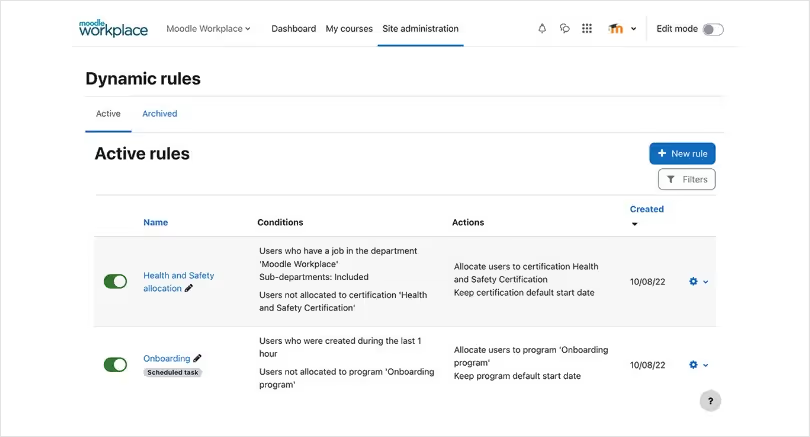
Overview
Moodle is the open-source LMS, widely used by educational institutions, corporations, and training organizations. Its modular design and extensive library of plugins make it highly customizable to fit diverse educational needs.
Moodle is especially helpful for universities, schools, and businesses looking for a free, flexible, and scalable LMS. It supports various formats like blended learning and flipped classrooms and caters to international audiences with multilingual support. From quizzes to discussion forums, Moodle equips educators to create dynamic and engaging courses.
People choose Moodle for its unparalleled customization and community support. As a free, open-source solution, it has no licensing fees and is constantly updated by its active user base. While setup can require some technical know-how, the platform’s powerful features make it worth the investment for institutions committed to comprehensive online education.
Key Features
- Real-time learner progress tracking
- Customizable course design
- Third-party tool integration
- Gamification options
- Personalized learning paths
Pros
- Highly customizable for a range of educational needs
- Strong community support for ongoing development
- Supports a wide variety of learning formats
- Regular updates and feature improvements
Cons
- Can have a steep learning curve for new users
- Some advanced features require additional plugins
Integrations
- Google Drive, Zoom, Microsoft Teams, and more
Ratings
- 4.7/5 based on user and community feedback
Pricing
- Free
3. Open edX

Overview
Open edX, developed by Harvard and MIT, is a premier open-source platform for delivering massive open online courses (MOOCs) and other large-scale educational programs. Its emphasis on scalability makes it suitable for universities and corporations offering education on a global scale.
This platform is built for institutions that need to accommodate thousands of learners. It is ideal for both academic settings and corporate training, offering features like video integration, peer assessments, and detailed analytics. Open edX supports self-paced and instructor-led courses, giving organizations flexibility in how they deliver content.
Open edX stands out for its MOOC-friendly structure and extensive customization options. It is an excellent choice for those who want a robust, scalable platform that can handle complex educational needs. However, it does require technical expertise to set up and manage, making it more suitable for well-resourced institutions.
Key Features
- Flexible course authoring
- Certification and badging capabilities
- Collaboration tools and discussion forums
- Third-party integration options
- Preview before course publishing
Pros
- Ideal for large-scale deployments
- Offers a wide range of customization options
- Highly scalable for different learning environments
- Strong community and institutional backing
Cons
- Requires technical expertise for setup and maintenance
- Limited support for small-scale institutions
Integrations
- Microsoft, Google, Zoom, and other industry-standard tools
Ratings
- 4.6/5 based on educational institution reviews
Pricing
- Free
4. Forma LMS
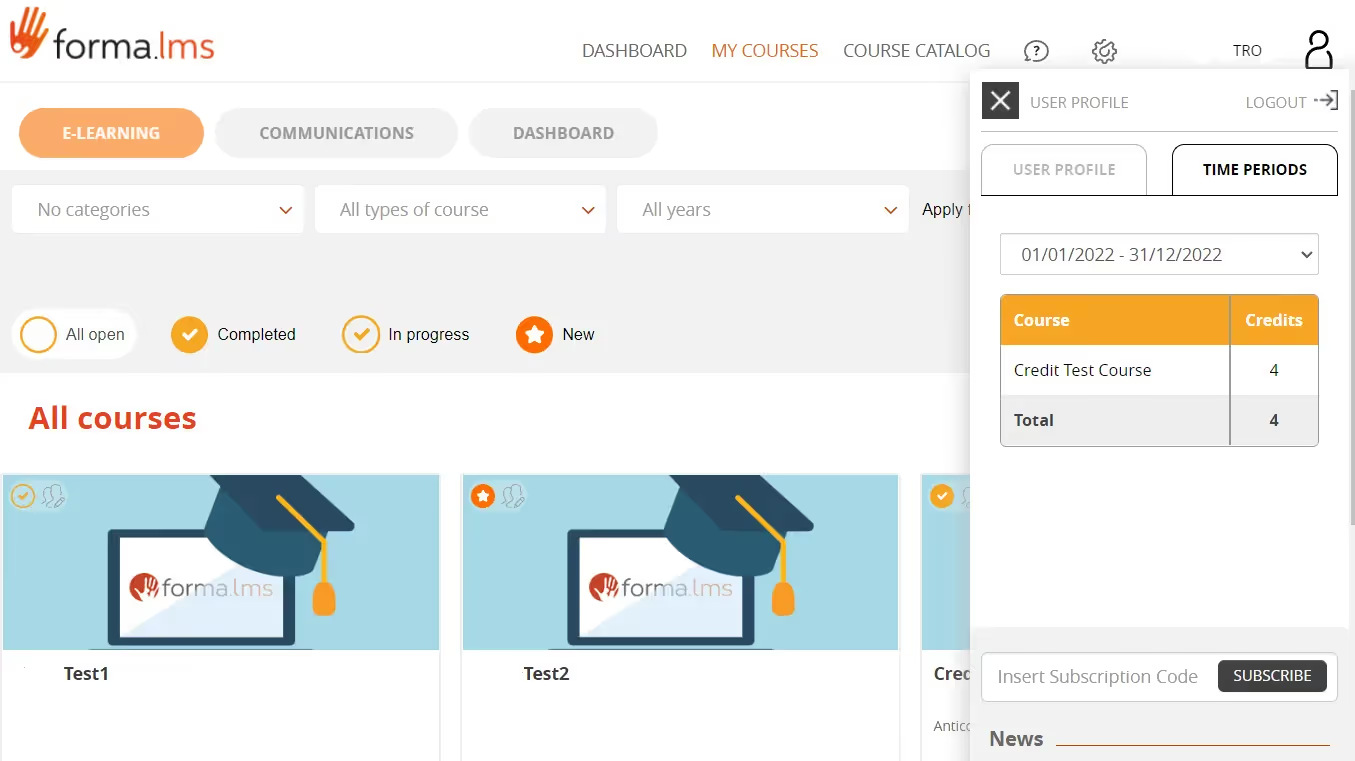
Overview
FForma LMS is designed with corporate training in mind, offering a user-centric interface and a variety of tools to manage online courses and employee training programs. It emphasizes efficiency and integration, making it a preferred choice for businesses.
The LMS helps HR departments, training managers, and organizations streamline e-learning content delivery and manage performance. It provides comprehensive reporting and customization options, which are essential for tracking employee progress and ensuring training objectives are met.
Choosing Forma LMS means opting for a platform that is built to simplify corporate training. It allows seamless integration with existing HR systems and has tools to automate administrative tasks, such as user enrollments and notifications, saving valuable time for large-scale training management.
Key Features
- Interactive learning tools
- Customizable certificate templates
- Scalability for large user bases
- Built-in scheduling for live events
- Integration with video conferencing platforms
Pros
- Easy to use for both educators and learners
- Strong support for professional and corporate training
- Scalable for large institutions
- Flexible certification and reporting tools
Cons
- Less customizable compared to other open-source LMS options
- May require third-party tools for advanced features
Integrations
- Zoom, GoToMeeting, Webex
Ratings
- 4.5/5 based on corporate training reviews
Pricing
- Free
5. Chamilo LMS

Overview
Chamilo is a lightweight, easy-to-use open-source LMS suitable for small to medium-sized educational organizations and businesses. It features an intuitive interface and a suite of tools for course creation, student assessments, and performance tracking.
Chamilo is particularly useful for schools and nonprofit organizations that lack extensive IT resources but want to implement effective e-learning programs. It offers SCORM compatibility and multimedia support, making courses more engaging without complex setup requirements.
Chamilo's appeal lies in its simplicity and speed of deployment. Even non-technical users can manage courses efficiently, and its community-driven development ensures continuous improvements. It’s ideal for organizations that need a straightforward, no-fuss LMS.
Key Features
- AI-powered plugins
- Virtual classrooms and live learning
- Social learning and gamification tools
- Personalized learning paths
- Scalable deployment for any institution size
Pros
- Excellent user engagement features
- Easy to use for both students and educators
- Customizable and scalable
- Strong community support and collaboration
Cons
- Some integrations may require additional plugins
- Limited advanced reporting tools compared to other platforms
Integrations
- Google Meet, Zoom, and other virtual tools
Ratings
- 4.4/5 based on academic user reviews
Pricing
- Free
6. Canvas LMS
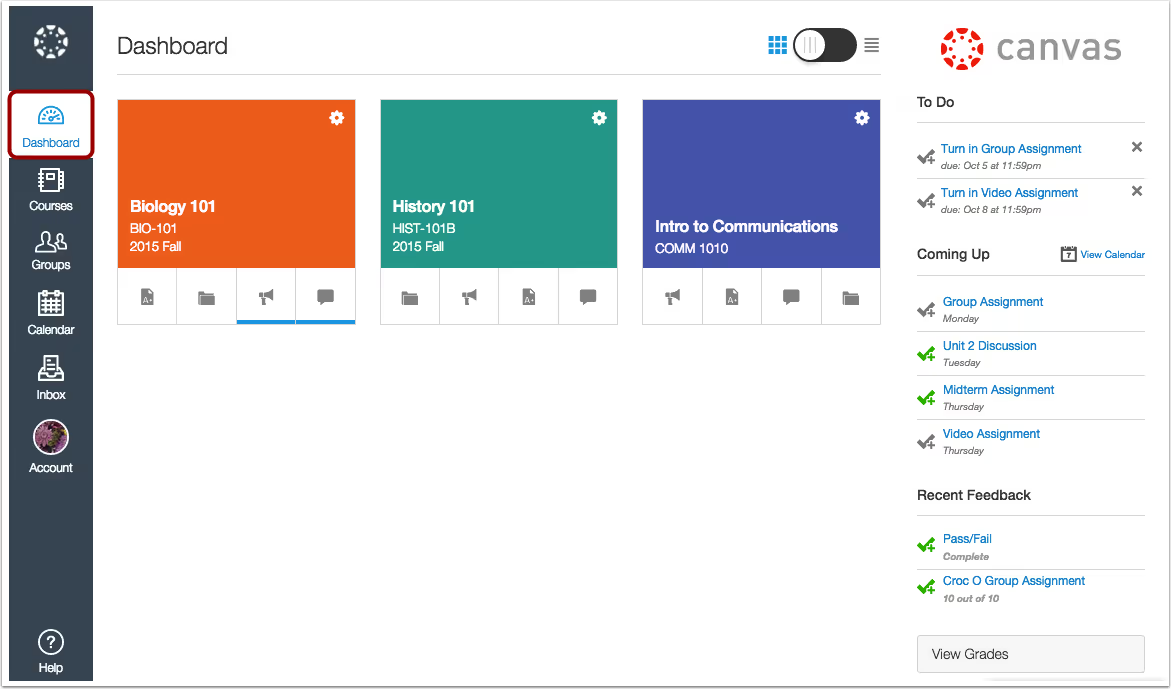
Overview
Canvas LMS is a well-known open-source platform used extensively by academic institutions. It offers a modern, cloud-based interface and a rich set of tools for interactive learning, assessment, and student engagement.
Canvas serves universities, K-12 schools, and even businesses by offering advanced features like analytics, collaborative tools, and third-party app integrations. Its mobile-friendliness makes it convenient for students who prefer learning on the go, and its flexibility caters to both traditional and innovative teaching methods.
Fellow Edupreneur chose Canvas LMS for its intuitive design, robust performance, and strong support community. It’s highly scalable and customizable, making it suitable for both small classrooms and large institutions. The extensive integration options ensure it can adapt to a wide range of educational environments.
Key Features
- Blended learning tools
- Built-in course authoring
- SCORM compliance
- Real-time course tracking
- Synchronous learning options
Pros
- Strong support for blended learning
- Easy to navigate user interface
- Excellent community support and frequent updates
- Flexible customization options
Cons
- Requires external integrations for advanced features
- Setup and deployment can be complex
Integrations
- Google Apps, Microsoft Teams, Zoom
Ratings
- 4.6/5 based on educational institution feedback
Pricing
- Free
7. Masteriyo LMS
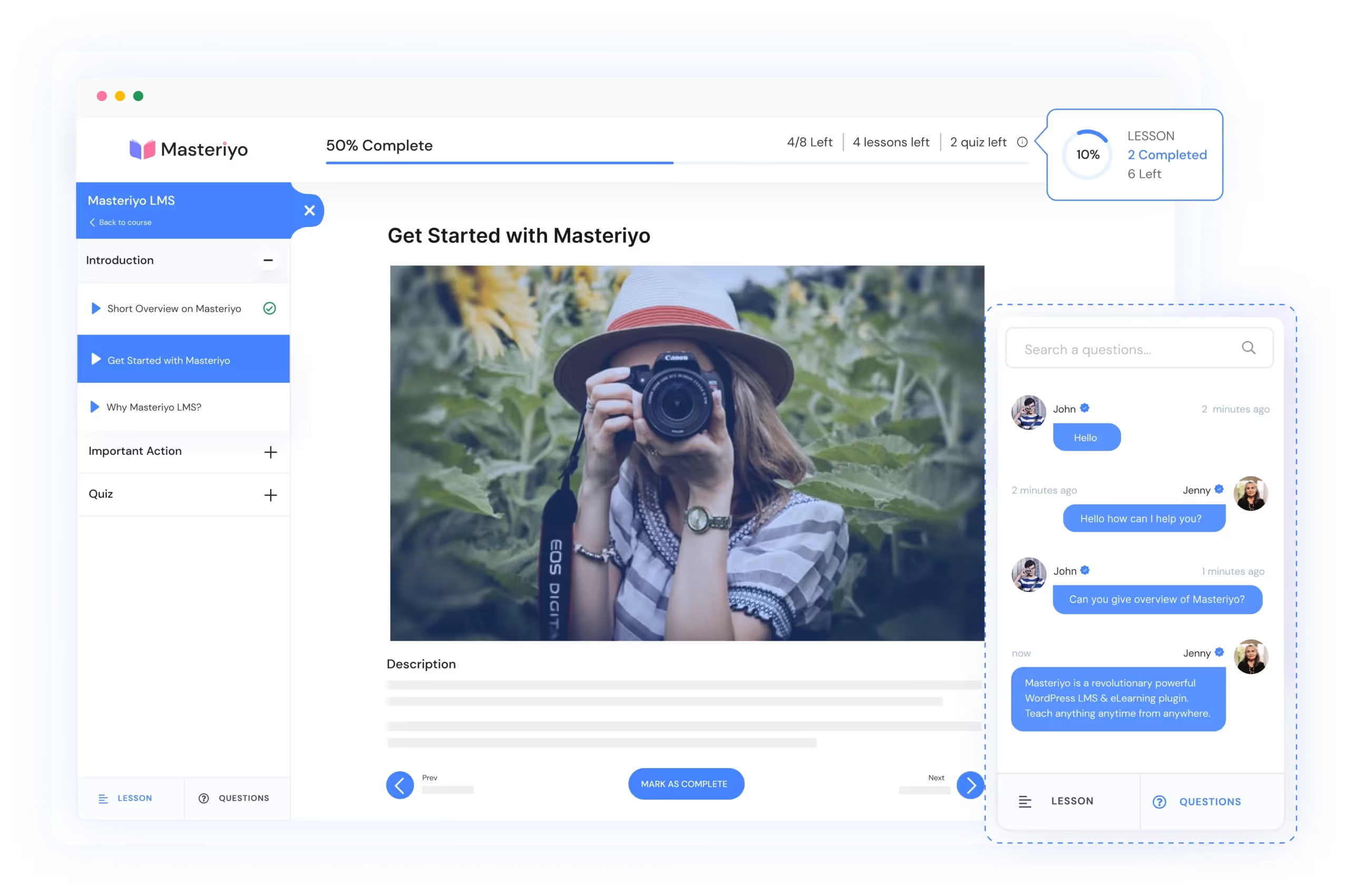
Overview
Masteriyo LMS offers a one-stop solution for educators seeking to simplify course creation and management. This open-source LMS platform combines a user-friendly interface with advanced features like robust quiz builders and content drip functionalities. Masteriyo is a great fit for small educational institutions and individual educators looking to Masteriyo LMS is a relatively new open-source platform focused on simplicity and streamlined course management. It is designed with an emphasis on user experience, making it a fantastic choice for smaller institutions and online educators.
The LMS targets individual instructors and small teams who wish to create, manage, and sell online courses effortlessly. Its drag-and-drop course builder and built-in e-commerce features simplify the process of setting up a learning business.
The main reason to choose Masteriyo LMS, it's all-in-one functionality. Where it combines course building, student management, and monetization in one package, making it convenient for those who want a hassle-free, integrated e-learning solution.
Key Features
- Single-page application interface
- Advanced quiz builder
- Content drip functionality
- Course archive page
- Elementor and Zoom integration
Pros
- Easy to use for both educators and learners
- Built-in tools for course management and assessment
- Perfect for smaller institutions and individual use
- Flexible integration with popular platforms like WordPress
Cons
- Limited scalability for large institutions
- Fewer customization options compared to larger platforms
Integrations
- Zoom, WordPress, Elementor
Ratings
- 4.3/5 based on individual educator reviews
Pricing
- Free
8. ILIAS LMS
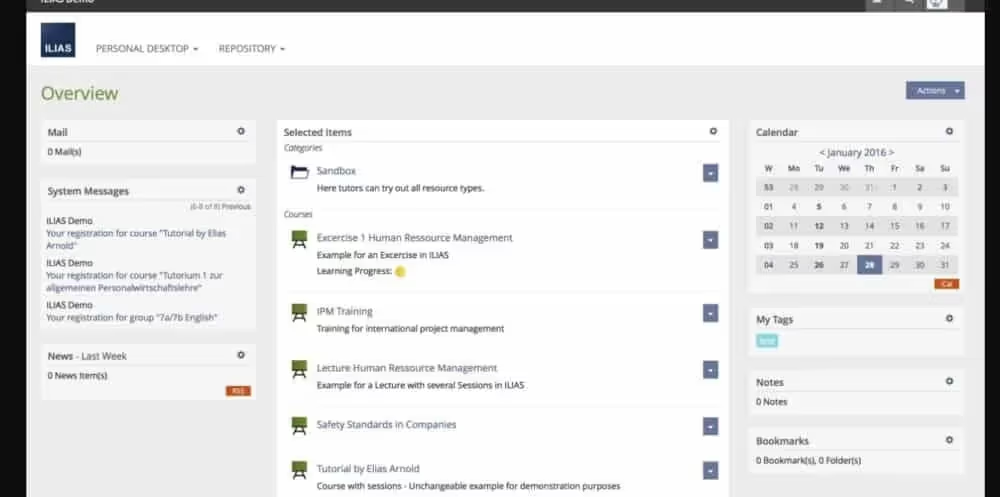
Overview
ILIAS LMS is a powerful open-source platform used by universities, public administrations, and corporate training departments. It offers a high degree of flexibility with features like personalized learning paths, assessments, and certifications.
This platform is highly beneficial for large organizations that require tailored training solutions. It caters to sectors where compliance and reporting are critical, such as healthcare and finance, providing tools to track and manage employee learning outcomes.
People select ILIAS LMS for its security features, comprehensive course management, and data-driven insights. Its adaptability means it can support diverse learning formats, from traditional classroom setups to fully remote learning, making it versatile for complex training environments.
Key Features
- Flexible configuration options
- Advanced testing and assessment tools
- Customizable learning paths
- Built-in collaboration features
- Scalability for large organizations
Pros
- Highly inclusive and accessible
- Powerful tools for course creation and assessment
- Strong collaboration and communication features
- Supports both academic and corporate use
Cons
- Complex interface for new users
- Requires some technical expertise for customization
Integrations
- Zoom, Webex, Google Workspace
Ratings
- 4.4/5 based on large institution feedback
Pricing
- Free
9. ATutor

Overview
ATutor is a unique, open-source LMS designed to be fully accessible and customizable. It focuses on ensuring courses are available to learners with diverse needs, supporting organizations that prioritize inclusive education.
This LMS is particularly helpful for educators and administrators who need to cater to students with disabilities. It allows easy course setup and includes features like adaptive assessments and real-time learner tracking.
Choosing ATutor is all about accessibility. It is one of the few LMS platforms that fully embrace the principles of universal design, ensuring everyone has equal learning opportunities. Its ease of use and strong focus on accessibility make it a top choice for institutions dedicated to inclusive education.
Key Features
- Accessible design for all learners
- Drag-and-drop course creation tools
- Strong assessment management features
- Content library for easy access to learning materials
- Self-paced learning options
Pros
- Highly accessible for all learners
- Easy-to-use interface with drag-and-drop features
- Excellent tools for managing assessments and content
- Supports a range of learning formats
Cons
- Limited advanced features for large institutions
- Basic customization options
Integrations
- Google Drive, Zoom, Microsoft OneDrive
Ratings
- 4.2/5 based on accessibility reviews
Pricing
- Free
10. OpenLMS
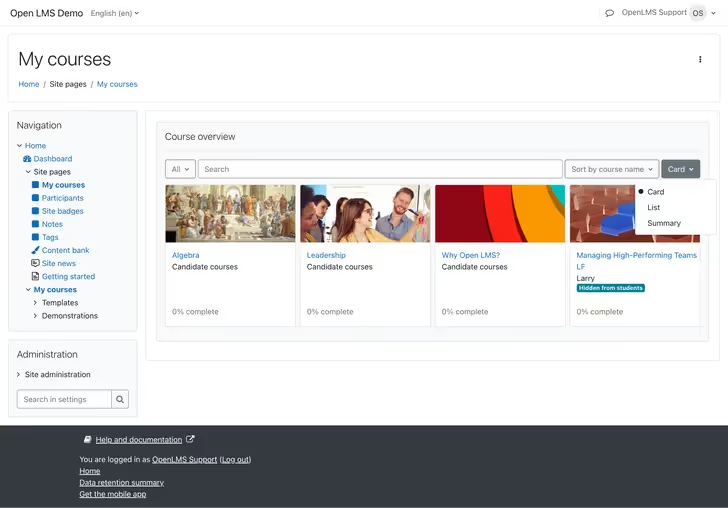
Overview
Open LMS is a powerful, open-source learning management system built on AWS cloud infrastructure, ensuring exceptional scalability and security. As a refined commercial version of Moodle, it is optimized for corporate and institutional use, enhancing core features with advanced hosting and comprehensive managed services to simplify implementation and maintenance. This makes Open LMS an ideal choice for organizations seeking a reliable, high-performance e-learning environment without the hassle of self-management.
This LMS is ideal for organizations that want Moodle’s open-source capabilities but prefer managed solutions. It caters to educational institutions and companies that need a reliable, secure, and fully supported LMS environment.
The reason to opt for Open LMS is the support and infrastructure it provides. Organizations that do not have the technical capacity to maintain an open-source platform can rely on its managed services, ensuring a smooth and hassle-free experience.
Key Features
- AWS cloud hosting for scalability
- Customizable interface and dashboard
- Large-scale online exam capabilities
- Multi-tenancy features for large institutions
- Comprehensive reporting tools
Pros
- Highly scalable for large institutions
- Secure cloud-based infrastructure
- Strong customization and reporting features
- Ideal for managing large-scale online exams
Cons
- Limited features for small institutions
- Requires AWS knowledge for advanced customization
Integrations
- AWS, Zoom, Google Apps
Ratings
- 4.5/5 based on cloud-hosted
Why choose an open-source LMS platform?
Facilitating the open source LMS tools opens the way to many opportunities for educators, trainers, and organizations at times. These learning management systems, ranging from economic viability to flexibility, provide multiple opportunities for learners to create fun, powerful, and impactful learning processes and experiences.
Cost-Effectiveness
Open source platforms have zero initial expenses and are often one of the features that make them a preferable alternative to proprietary systems since they do not have licensing costs.
Consequently, they heighten their availability because they are affordable, which allows them to target institutions and organizations that could not afford them in the past and now have the opportunity to be funded for other educational initiatives.
Flexibility and Customization
In contrast, open source LMS platforms provide unprecedented flexibility in that users can adjust the software to fit their specific needs as required, which can be a tough call shortly. Modifying any aspect of the platform (adding/integrating new features or tools, modifying the UI) doesn't matter; the users have the autonomy to change the system by evolving requirements and learning goals.
Community Collaboration
Communities based on this open source software become grounds for co-creation, creativity, and stability within a circle of coders, teachers, and users. The soul of this collaborative approach is resource sharing, best practice spreading, and boosting, which ensure the platform is always fresh, responsive, and improving.
Scalability and Accessibility
Scalability is one of the striking features of an open source LMS platform. Unlike their proprietary counterparts, Learning Management System platforms open source platforms can easily accommodate and support a growing user base with more specific educational projects.
In addition, the platforms have the scalability and accessibility needed to meet the needs of expanding educational landscapes, which may concern geographical or traffic issues.
Transparency and Security
The transparent nature of open source LMS platforms brings with it increased transparency into the workings of software code-based and the development processes for users. This helps establish trust and accountability, as the users can effectively verify the security measures in place and cooperate to identify and resolve issues or vulnerabilities quickly, which helps protect data and ensure system reliability.
What are the key features to consider in an open-source LMS platform?
When choosing the best open-source LMS, it’s essential to consider key features that enhance the learning experience:
- Customizable Learning Paths: Tailor the learning experience to individual students’ needs.
- Third-Party Integrations: Support for tools like Zoom, Google Drive, and more to enhance functionality.
- Robust Reporting and Analytics Features: Track student progress with detailed reporting and data analysis to assess learners' performance and pinpoint areas needing improvement.
- Mobile Compatibility: Ensure the platform is accessible across devices for flexible learning.
- Collaborative Learning Tools: Promote group work and discussion forums to enhance interaction.
- Security: Strong security measures to protect user data and ensure reliability.
Conclusion
Choosing the right open-source LMS platform is a pivotal decision for educational institutions and organizations aiming to deliver effective and engaging online learning experiences. Each platform offers unique features, flexibility, and customization options to meet a variety of needs. Whether it’s cost-effectiveness, scalability, or ease of integration, open-source LMS platforms like EdisonOS, Moodle, and Open edX provide a wide range of benefits tailored to different environments. By considering factors like customization, security, and community support, you can select an LMS that grows with your organization and enhances the overall learning experience

Tutors Edge by EdisonOS
in our newsletter, curated to help tutors stay ahead!
Tutors Edge by EdisonOS
Get Exclusive test insights and updates in our newsletter, curated to help tutors stay ahead!











.png)
.webp)
